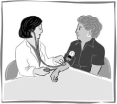| |
What to Discuss with Patients with Diabetes
 This section provides messages that you as a health care provider should discuss with people with diabetes about foot, eye, and oral health and about drug therapy management. The bullets highlight questions to ask and information to discuss about diabetes-associated risks, the benefits of comprehensive care, the need for regular medical examinations, symptoms to look for, and self-care issues. You can discuss these topics, when appropriate, over a series of patient visits; you need not cover all the material with every patient. Guidelines for referral to other health care providers are also provided. This section provides messages that you as a health care provider should discuss with people with diabetes about foot, eye, and oral health and about drug therapy management. The bullets highlight questions to ask and information to discuss about diabetes-associated risks, the benefits of comprehensive care, the need for regular medical examinations, symptoms to look for, and self-care issues. You can discuss these topics, when appropriate, over a series of patient visits; you need not cover all the material with every patient. Guidelines for referral to other health care providers are also provided.
Key Messages all Health Care Providers Can Reinforce
-
Emphasize the importance of metabolic control (ABCs).
-
Promote a healthy lifestyle.
-
Explain the benefits of diabetes comprehensive team care.
-
Recommend routine exams for complication prevention: oral health, comprehensive foot exam, complete dilated eye exam.
-
Reinforce self-exams.
-
Recognize danger signs and seek help.
-
Promote pharmacist role in drug therapy management.
Promote the ABCs—A1C, Blood Pressure, and Cholesterol
 It is important to control risk factors for cardiovascular disease. Ask about the ABCs of diabetes. It is important to control risk factors for cardiovascular disease. Ask about the ABCs of diabetes.
-
Ask: “Do you know your ABC goals and how to reach them?” Recommend working with the health care team to determine both long-and short-term goals for each ABC.
-
Advise: “You can take action to prevent or delay type 2 diabetes complications.” Controlling the ABCs can reduce the risk for heart attack and stroke, and inform them that poor control can lead to problems in foot, eye, and oral health. Explain that screening and team care can prevent complications.
-
Assist: Refer to a primary care provider. Give your patients resources to help them make healthy changes by contacting the National Diabetes Education Program (NDEP) for FREE information and materials on diabetes prevention and control. Recommend that they call 1-800-438-5383 or visit www.ndep.nih.gov.
Promote a Healthy Lifestyle
 Healthy lifestyle is key to diabetes control. Healthy lifestyle is key to diabetes control.
- Weight. Advise people with diabetes to aim for a healthy weight. Emphasize the importance of setting stepwise and realistic goals for weight reduction.
- Healthy Food Choices. Encourage meal planning that includes a variety of foods and controls portion sizes and snacks. Increasing fiber and limiting saturated fats and salts will help control blood glucose, blood pressure, and cholesterol. Recommend consultation with a dietitian for additional help with meal planning and learning how to make healthy food choices.
- Physical activity. Advise people with diabetes that moderate physical activity (such as walking) can help control the ABCs and prevent complications.
- Self-management. Ask people with diabetes to identify their high priority concerns. Prompt them to plan for challenging situations and set short-term achievable goals. Compliment them on any steps taken toward these goals. See “Self-Management Support” in the previous section.
- Tobacco. Ask about tobacco use. Encourage people with diabetes to avoid smoking and using smokeless tobacco products. Recommend calling the FREE tobacco quit line 1-800-QUITNOW. People who use tobacco are at greater risk for stroke; heart, kidney, and eye diseases; nerve damage; and lower-extremity complications. To learn more about tobacco cessation strategies, consult the CDC’s Tobacco Information and Prevention Source (TIPS) Web site at www.cdc.gov/tobacco/.
Explain the Risks of Disease and Benefits of Care
People with diabetes make daily decisions that affect their diabetes control. Cornerstones of diabetes self management include meal planning, physical activity, and self monitoring of blood glucose. Routine self-care behaviors also impact diabetes complications prevention. See appendix C for a list of common diabetes-related foot, eye, and oral health complaints and examples of inappropriate self-care.
At each patient encounter, remind patients of the risks of diabetes complications and the benefits of foot, eye, and oral health care as well as drug therapy management. Ask about annual screening exams. Ask about routine self-care behaviors. Assess symptoms that warrant urgent referral.
Foot health. Ask people with diabetes if they know how diabetes affects their feet. Explain that diabetes raises the risk of foot ulcers, which can lead to amputation, and that proper foot care reduces their risk.
-
Foot exams. Ask people with diabetes if they have had a comprehensive foot examination (including a sensory exam with a monofilament) in the past year. Recommend a comprehensive annual foot exam by a podiatric physician or primary care clinician and a foot inspection (visual foot check) at every primary care provider visit.
Daily foot care. Ask about proper daily foot care. People with neuropathy may not notice injuries as they do not feel pain. Advise all people with diabetes to take the following steps:
-
Examine feet daily, both by looking and touching. Look for cuts, bruises, puncture wounds, corns or calluses, areas of redness, or pus. Seek podiatric medical advice right away for these symptoms.
-
Clean feet (both skin and nails) daily and dry the spaces between the toes gently. Check the insides of shoes for objects before putting them on.
-
Never walk barefoot, not even indoors. Wear appropriate footwear, such as athletic or walking shoes that fit well and cover the feet (i.e., NOT sandals).
-
Foot symptoms. Ask about foot symptoms and recommend prompt podiatric medical attention for bruises, lacerations, puncture wounds, swelling, and areas of redness or pus from any area of the foot. These signs and symptoms can be the earliest harbingers of serious injury leading to amputation. Be proactive.
-
Refer people with these symptoms to a podiatric physician or to their primary care provider.
Eye health. Advise people with diabetes about the risk of diabetic retinopathy, a leading cause of blindness in adults and one that may be prevented or delayed by good control of blood glucose. People with diabetes also may be at greater risk for eye problems such as cataracts and glaucoma. Ocular symptoms associated with diabetes include fluctuation in visual acuity, double vision, dry eye, recurrent lid infections (blepharitis) and changes in color vision.
-
Eye exams. Ask when the person with diabetes last had a comprehensive dilated eye exam by an optometrist or an ophthalmologist. Reinforce the need for regular screening eye exams to prevent or delay the onset of blindness due to diabetic retinopathy. Most people with diabetes should have a dilated eye examination by an optometrist or an ophthalmologist annually. An eye care provider may suggest less frequent exams (every 2–3 years) in the setting of a normal eye exam (30). Examinations will be needed more frequently if retinopathy exists or is progressing.
-
Eye care. Advise people with diabetes to report eye symptoms to their health care provider and to maintain a current prescription for eyeglasses, contact lenses, or low-vision aids.
Eye symptoms. Ask about eye symptoms and their frequency and duration. Encourage people with diabetes to report any changes in their eyes or vision, such as sudden onset of blurriness, seeing spots, or persistent redness or pain to their health care provider.
 Oral health. Explain the link between poor control of blood glucose and periodontal (gum) disease. Good oral health may help control diabetes—and controlling blood glucose levels my contribute to improved oral health.
-
Oral health exams. Ask the date of the last dental/oral health exam. Stress the importance of good oral hygiene and regular exams, including regular cleanings performed by a dental hygienist or dentist to prevent periodontal disease. Even people with who wear dentures or have no teeth need an oral health exam once a year to screen for cancer, infection, or other lesions.
-
Daily oral care. Advise about the need to brush the teeth after eating and to floss at least once a day. If dentures are worn, advise about their care: daily cleaning and a dental visit if dentures become loose or irritation develops.
-
Monthly oral self exam. Advise people with diabetes to do a monthly self exam and to contact their dentist if they notice signs
of infection, such as sore, swollen, or bleeding gums; loose teeth; or mouth ulcers.
-
Oral symptoms. Ask about oral health symptoms that may indicate infection such as a bad taste or bad breath, or pain. Evaluate whether an acute problem, such as infection, is present that requires immediate attention.
-
Refer individuals with oral findings or complaints to a dentist or periodontist and/or their primary care provider, as indicated.
-
Oral infections may worsen glycemic control, progress to serious complications quickly, and need prompt treatment.
-
Drug therapy management. Discuss the benefits of proper drug therapy management. Recommend that your patients with diabetes talk with their pharmacist about how to get the most benefit from medications by individualizing dosage regimens. Pharmacists can provide regular medication reviews to ensure that people with diabetes take medications as prescribed and understand the risks of using over-the-counter (OTC) medications.
Regular Medication Review. Advise people with diabetes that regular medication reviews, individualized drug regimens, and screening for interactions and side effects from medications, OTC medications, herbal products, and supplements can help them get the most from their drug therapy.
-
Medications. Ask people with diabetes if they take their medication exactly as prescribed. Advise them to talk to their pharmacist or primary care provider if they are unable to follow the medication plan prescribed.
Drug Therapy Management Medication-related symptoms.
-
Ask at every visit about medication use.
-
Ask people with diabetes to report any changes in symptoms, medical conditions, medications, doses, supplements, or lifestyle
to all health care providers.
-
Refer individuals to a pharmacist or primary care provider,
as indicated, for evaluation.
-
Selection and use of a blood glucose meter. Refer people with diabetes to a pharmacist or diabetes educator for help in choosing
an appropriate blood glucose meter, learning how to use it, and under-standing the results to check how medications are working.
-
ABC monitoring. Ask your patients with diabetes when they last had their A1C, blood pressure, and cholesterol levels checked and if they know the results of these tests.
-
Personal ABCs. Ask if they know what they need to do to control their ABCs. Advise about the ABC goals: A1C <7, BP <130/80, LDL cholesterol <100. Even if a person has not reached these goals, there is benefit in decreasing their A1C, blood pressure, and cholesterol towards these goals.

How can a busy health care provider find the time to give the key team care messages?
Suggestions:
- Don’t give every message at one appointment.
- Customize and prioritize messages according to the patient’s needs.
- Establish a blueprint of messages over a period of client appointments.
- Provide patient with a computer generated reminder of key messages discussed at each appointment.
- Document what is accomplished at each appointment and the patient’s response.
- Create pamphlets for office or use NDEP materials.
- Include key messages in office newsletters.
- Offer health awareness program for patients with diabetes.
- Establish referral base in the community.
Table 4. Summary-What to Discuss with Patients with Diabetes
This table outlines messages that health care providers should discuss with people who have diabetes
regarding foot, eye, and oral health and about drug therapy management.
Health care providers in these four disciplines are well positioned to deliver these overarching prevention messages,
communicate the need for metabolic control, and encourage multidisciplinary team diabetes control.
Promote the ABCs—A1C, Blood Pressure, and Cholesterol: |
Ask about Health Examinations: |
- Controlling the ABCs can prevent complications and reduce the risk of stroke and heart attack.
- Ask: “Do you know your ABC goals and how to reach them?”
- Explain that poor ABC control can also lead to problems in foot, eye, and oral health.
|
- Foot exams.
- Eye exams.
- Oral health exams.
- Drug therapy management.
- ABC monitoring and control.
|
Promote a Healthy Lifestyle: |
Support Self-Care Behaviors: |
- Weight control.
- Healthy food choices.
- Daily physical activity.
- Support self management.
- No tobacco use (call 1-800-QUITNOW for help).
|
- Daily foot care.
- Eye care.
- Daily oral care.
- Monthly oral self-exam.
- Selection and use of a blood glucose monitor.
- Know your ABC goals and how to reach them.
- Medication management.
|
| Explain the Risks and Benefits of Diabetes Comprehensive Control: |
Assess Symptoms that Require Referral: |
- Foot health.
- Eye health.
- Oral health.
- Drug therapy management.
|
- Foot symptoms.
- Eye symptoms.
- Oral symptoms.
- Medication-related symptoms.
|
Table 5. Summary-What to Discuss with Patients with Diabetes
The information below lists some of the common issues specific to foot, eye, and oral health, and drug therapy management.
When health care professionals understand the diabetes care issues of other disciplines, they can recognize symptomatic concerns warranting urgent referral, reinforce annual screening recommendations, and contribute to a proactive approach to diabetes care beyond the scope of their particular discipline.
Foot Health |
Eye Health |
Oral Health |
Drug Therapy Management |
| Diabetes-Related Foot Conditions: |
Diabetes-Related Eye Conditions: |
Diabetes-Related Oral Health Conditions: |
Diabetes drug management issues: |
| – Neuropathy |
– Retinopathy |
– Changes in the oral cavity |
– Improper drug choice |
| – Vasculopathy |
– Double vision |
– Periodontal disease |
– Underdosage |
| – Dermatological conditions |
– Vision fluctuations |
– Oral Candida (thrush) |
– Overdosage |
| – Musculoskeletal problems |
– Cataracts |
|
– Adverse drug reactions |
| |
– Macular edema |
|
– Drug interactions |
| |
– Ocular nerve palsy |
|
– Undertreatment |
| |
|
|
|
| Comprehensive Foot Examination to identify the high-risk foot: |
Comprehensive Eye Examination: |
Comprehensive Oral Examination: |
Strategies for Managing Drug Therapy: |
| – Loss of protective sensation |
– Visual acuity |
– Teeth |
– Use of medications |
| – Skin and nail condition |
– Visual fields |
– Gums |
– Monitoring treatment |
| – Absent pedal pulses |
– Pupillary reaction |
– Periodontal probing |
– Self treatment and OTC medications |
| – Foot deformity |
– Intraocular pressure |
– Intraoral lesions, infections, or masses |
– Selecting and using a blood glucose meter |
| – History of foot ulcers |
– Cranial nerves |
– Adequate saliva flow |
– Cost control |
| – Prior amputation |
– Slit-lamp exam |
|
|
| |
– Dilated retinal exam
Coordination of |
|
Coordination of Care |
May 2007 |
|





 This section provides messages that you as a health care provider should discuss with people with diabetes about foot, eye, and oral health and about drug therapy management. The bullets highlight questions to ask and information to discuss about diabetes-associated risks, the benefits of comprehensive care, the need for regular medical examinations, symptoms to look for, and self-care issues. You can discuss these topics, when appropriate, over a series of patient visits; you need not cover all the material with every patient. Guidelines for referral to other health care providers are also provided.
This section provides messages that you as a health care provider should discuss with people with diabetes about foot, eye, and oral health and about drug therapy management. The bullets highlight questions to ask and information to discuss about diabetes-associated risks, the benefits of comprehensive care, the need for regular medical examinations, symptoms to look for, and self-care issues. You can discuss these topics, when appropriate, over a series of patient visits; you need not cover all the material with every patient. Guidelines for referral to other health care providers are also provided. It is important to control risk factors for cardiovascular disease. Ask about the ABCs of diabetes.
It is important to control risk factors for cardiovascular disease. Ask about the ABCs of diabetes. Healthy lifestyle is key to diabetes control.
Healthy lifestyle is key to diabetes control.





